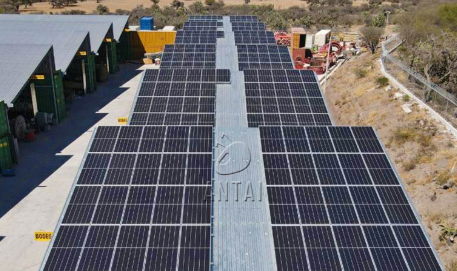Installing Solar on Concrete Tile Roofs: A Technical Overview
October 27, 2025
Working with concrete tile roofs presents a distinct set of considerations for solar installation teams. The weight, fragility, and irregular surface of these tiles demand a mounting system designed for precision and care. At Antaisolar, we approach this challenge with solutions that prioritize preservation of the roof structure and installer safety. Our methodology ensures that adding solar power enhances the property without compromising the existing roof's integrity or warranty.

The Advantage of a Specialized Hook System
The key to a successful project lies in the initial attachment point. For concrete tile roofs, a generic mounting approach carries unnecessary risk of damage and potential leaks. Our dedicated Hook System is engineered to address this directly. It is designed to integrate with the natural overlaps and contours of the tiles, securing directly to the underlying rafters without placing undue stress on the fragile concrete itself. This targeted approach minimizes the need for tile cutting or modification, preserving the roof's weatherproof barrier and its aesthetic appeal. For installers, this means a cleaner, faster, and more secure process. For project developers and building owners, it translates to a reduced risk of callbacks and a clear preservation of the roof's value, making the concrete tile roof solar mounting system a reliable component of the overall energy solution.
Proven Performance in Diverse Environments
The true measure of a mounting system's quality is its performance in real-world conditions across different geographies. Our concrete tile roof solar mounting system has been deployed in a variety of climatic and regulatory environments, demonstrating consistent reliability. For instance, a 50 MW project in Singapore utilized our system across a large commercial building, validating its capacity for significant scale. Similarly, a 500 KW installation in Mexico proved its resilience in a different climate, while a 99.68 KW project in South Korea showcased its adaptability to regional standards and roof designs. These examples illustrate a common result: a secure installation that performs over time. The system is built to handle specific environmental loads, such as wind and snow, ensuring the solar array remains a stable and productive asset for the long term.
In final analysis, the technical requirements for mounting solar on concrete tile roofs are met through careful engineering and proven application. The process requires a system that respects the roof's structure, ensures a weather-tight seal, and has a verified history of performance. At Antaisolar, our Hook System is developed to meet these specific demands, providing a dependable foundation for solar projects. Our focus is on delivering the practical and technical advantages that allow installers and developers to execute projects with confidence, turning complex roofs into opportunities for energy generation.

The Advantage of a Specialized Hook System
The key to a successful project lies in the initial attachment point. For concrete tile roofs, a generic mounting approach carries unnecessary risk of damage and potential leaks. Our dedicated Hook System is engineered to address this directly. It is designed to integrate with the natural overlaps and contours of the tiles, securing directly to the underlying rafters without placing undue stress on the fragile concrete itself. This targeted approach minimizes the need for tile cutting or modification, preserving the roof's weatherproof barrier and its aesthetic appeal. For installers, this means a cleaner, faster, and more secure process. For project developers and building owners, it translates to a reduced risk of callbacks and a clear preservation of the roof's value, making the concrete tile roof solar mounting system a reliable component of the overall energy solution.
Proven Performance in Diverse Environments
The true measure of a mounting system's quality is its performance in real-world conditions across different geographies. Our concrete tile roof solar mounting system has been deployed in a variety of climatic and regulatory environments, demonstrating consistent reliability. For instance, a 50 MW project in Singapore utilized our system across a large commercial building, validating its capacity for significant scale. Similarly, a 500 KW installation in Mexico proved its resilience in a different climate, while a 99.68 KW project in South Korea showcased its adaptability to regional standards and roof designs. These examples illustrate a common result: a secure installation that performs over time. The system is built to handle specific environmental loads, such as wind and snow, ensuring the solar array remains a stable and productive asset for the long term.
In final analysis, the technical requirements for mounting solar on concrete tile roofs are met through careful engineering and proven application. The process requires a system that respects the roof's structure, ensures a weather-tight seal, and has a verified history of performance. At Antaisolar, our Hook System is developed to meet these specific demands, providing a dependable foundation for solar projects. Our focus is on delivering the practical and technical advantages that allow installers and developers to execute projects with confidence, turning complex roofs into opportunities for energy generation.
end
